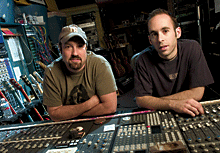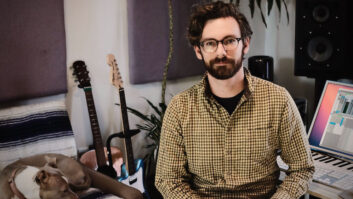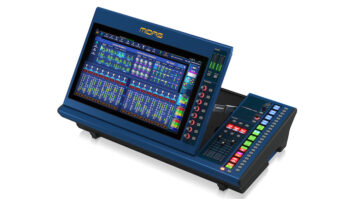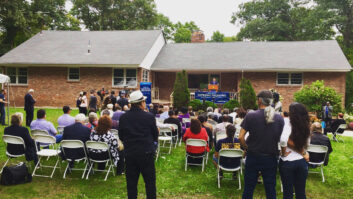
John Shanks is one of the hottest pop producers around. For four years in Studio C at Los Angeles — based Henson Studios, the guitarist, songwriter and producer has worked with some of the biggest names in the business, from Sting to Sheryl Crow to Santana. Equally sought after for his songwriting skills as his studio expertise, Shanks seems to have the Midas touch, and his name has graced several chart-topping albums and more than a dozen Top 20 singles in the past year-plus. His Number Ones include Crow’s cover of “First Cut Is the Deepest,” Kelly Clarkson’s “Breakaway” and Ashlee Simpson’s “Pieces of Me” (which he co-wrote). A former VP of A&R at Atlantic between 2001 and 2003, the three-time Grammy nominee finally won one of the coveted statuettes this year for Producer of the Year, Non-Classical in February.
John Shanks (left) and Jeff Rothschild in their natural habitat—at the board
photo: Sebastian Artz
Shanks, a lifelong guitarist, began his career as a session and touring musician, and by 1995, he had played on albums by artists including Fleetwood Mac, Chris Isaak, Rod Stewart, Curtis Stigers and Melissa Etheridge. His decade-long touring and, later, recording tenure with Etheridge, which actually began in 1988, culminated in his producing the rock icon (and co-writing the Grammy-nominated song “Angels Would Fall”) for her Grammy-nominated album Breakdown in 1999. He also recorded and toured with Stewart for two years.
Since then, Shanks has parlayed his success and skills into valuable musical capital, working with artists in pop (Michelle Branch, Alanis Morissette), rock (Robbie Robertson, Bon Jovi) and country (Keith Urban, SHeDAISY). While he has worked with plenty of veteran artists during the years, Shanks has also become known for injecting a rock edge into the pleasing pop sounds of young female artists such as Clarkson, Hilary Duff and Lindsay Lohan. When Shanks and his longtime engineer and co-mixer, Jeff Rothschild, took time out from their heavy production schedule to speak with Mix, they were working on Crow’s new album and Simpson’s sophomore release, and had just wrapped up the latest Bon Jovi CD, Have a Nice Day.
For you, what makes a great pop song?
John Shanks: A great chorus. To me, there are three things — the music, the melody and the lyric — and when you can match all three and connect them, hopefully you come up with a great song. When the music matches the emotion of the lyric and the melody, you’ve got something special.
I always like it when every section of a song matters.
Shanks: Absolutely. When Jeff and I are working, we try to make every section [count]. It’s almost like a movie or a ride. You should put on those headphones or sit between those speakers, and it should take you somewhere emotionally. That’s why we’re very concerned with each section: the intro, the verse, things coming in and out. When we sit down and listen to records that we like from producers who we like, there’s always a little something — ear candy — that’s coming in and out that we think is great. That little guitar comes in during the second chorus, or that other background vocal comes in during the second chorus, and [during] the third chorus, this counterpoint starts happening. That’s what makes stuff exciting.
b>Given the thousands of pop songs that have been released, how do you find something new to do or say with the format?
Shanks: There are certain songs like “Breakaway” that I produced and Jeff engineered, and then we mixed it. That was a song where you go, “Here’s a really strong song, how do we get it to the next level? How do we keep it true to where the song is coming from and yet make it sound exciting?”
Jeff Rothschild: I think you’re always taking on influences, but also keeping things fresh.
Someone like Sheryl Crow has more of a timeless sound for some people, being rooted in classic rock.
Rothschild: Then you take those influences and [give them] the impact that works on radio — you take the best of both worlds.
Shanks: You can use “First Cut Is the Deepest” as an example. Here’s a song that was a hit in the ’70s. How do you keep it true and yet make it fresh and contemporary? Sometimes there are subtle things that we do — whether it’s in the drum groove or the way the guitars or harmonies are layered — that make it sound fresh.
When did you two first meet and how has your relationship evolved since then?
Rothschild: We have a room at Henson Studios, and I used to work for the studio as an assistant. I actually started as a runner, was an assistant for a while and then started engineering for John here and there. It just became more and more often, and then I got to the point where it was pulling me both ways, so I basically left the studio.
Shanks: It got to the point where we started getting into a rhythm in working on projects in this room. We work off a Euphonix [CS-3000] board here on Pro Tools, and it was great that while a lot of these guys were learning SSLs, Jeff was also learning the Euphonix. So he really had an advantage of not only being a great engineer and great with computers, but he knew about miking and recording and engineering and working with Pro Tools. These guys are the new generation of engineers, to a certain degree, who have respect for the past but also have their eye on the future, which is incredibly valuable. With what I do as a writer, someone who is very fast with Pro Tools gets the ideas developed that much quicker.
Initially, I was hiring Jeff as an engineer — as a Pro Tools operator — because early on, it got to the point where engineering was too much for me: playing guitar and punching myself in with a foot pedal or whatever I had to do. It was just nuts.
You can tell when guys come in as second engineers who have the drive and the discipline and the focus. You can tell who wants it and who doesn’t mind putting in the time and the hours and just loves the process. Jeff is one of those guys who is very driven. His first session was with Lindsey Buckingham. He was stepping up from a second engineer to an engineer and recording Fleetwood Mac. Then it got to the point where the studio needed him on other sessions. I said, “Listen, as long as I’m working, we’re going to be working.” So it was a big step three years ago. He was like, “Screw it, let’s do it.” Thank God we haven’t stopped.
Now it’s branched off into mixing more because we record these albums, and the record companies get used to hearing the way these roughs sound. To us, they’re not roughs at all — we’re making records. If I’m writing a song and we’re doing a demo, it’s always a record.
We go back and sweeten it and tweak it and tighten it. If it’s now the single on someone’s record, we go in and get meticulous on it. I did Michelle Branch’s first record in a little mastering room. We’ll go in the big room and do drums and strings and pianos and Hammond, but for the most part, Studio C is a very small environment. It’s where Joni Mitchell’s Blue and Carole King’s Tapestry were done. It’s a very small live room, small control room, so it’s great for a more controlled environment when you’re writing and recording songs because you can focus on each aspect of the recording process.
Is your process together generally smooth or do you often argue or debate?
Rothschild: We’ve been working together so long that we have a system down with each other. It gets stressful, but there are never any problems on the technical side.
Shanks: The great thing about the [Euphonix] board that we use is we can jump around from song to song within a project or other projects. For example, today we’re working on a project and we’re sending out another song to be mixed. Or we just have to import some strings from another studio where we cut strings last night. Everything becomes very seamless because we can snapshot mixes, and we can pick up where we left off on a song we worked on three days ago. It makes it very convenient. Any time we butt heads, it’s usually about silly things like, “Can this be better?” or, “Can we check this out?”
So you work in the same room all the time?
Shanks: I’ve been in Studio C in Henson for four years, so all my guitar amps, all the keyboards and all the guitar racks are set up. Every amp is miked. The vocal mics are all set up. The drum mics are always set up.
Rothschild: There’s really no setup time. We can jump around from acoustic guitar to vocals to electrics to bass without any down time.
Do you consider yourselves to be analog, digital or hybrid men?
Rothschild: We’re definitely hybrid. There are racks and racks of outboard gear and we still use all that stuff. Then there’s Pro Tools and a digitally controlled analog console.
Shanks: We’re recording through APIs and Neves [preamps] all the time. That’s just the way it is. Old mics. All the gear is vintage Tweed amps, vintage Vox amps, vintage Marshall amps, a vintage Gretsch kit. We have about 100 vintage guitars and pedals.
For a guitarist, it must be like being a kid in a candy store.
Shanks: We just did Bon Jovi’s record, and it was great. Richie [Sambora] came in here and used all my guitars and amps. We had a blast.
John, you have a strong pop background, while Jeff has also worked with some metal bands like Motörhead and Spineshank. Do you think having diverse production backgrounds augments your synergy?
Shanks: Yeah. I’ve done rock stuff, but to me, it’s always about the song. It doesn’t matter what it is — if it’s country or Nordic speed metal. If there’s a good lick, that’s what I gravitate toward. Those amps still have to be miked and it depends on what amp you’re using. We’ve got everything from AC30s to Boogie and Diesel amps. I’ve got seven-strings and detuned [guitars], so it really depends on the song and the artist you’re working with.
John, how did working with Melissa Etheridge influence your work as a producer?
Shanks: While working with Melissa, we did a few albums with [producer] Hugh Padgham. I used to be a session player, too, so I got to work with a lot of different producers around town — you really learn who’s a great producer, and you learn their rhythm and what separates different guys. For me, someone like Hugh Padgham was a great mentor and teacher.
By the end of those records, it was always myself and Melissa doing guitars and vocals, and I was playing some of the keyboards at times. So I got to really ask him every goofy, geeky question about miking and compression, and I saw how he made records and was not afraid to ask. Even when I would work with other producers, they would get some great guitar sound or great vocal sound, and I would ask, “How did you do that?” You can put a Stratocaster into any guy’s hands, but it’s what they do with it. I might have the information, but over years and years of collectively building it up is where you start developing your style.
When I was producing all these baby bands, Melissa wanted me to produce her album, and she got nominated for two Grammys on that record [Breakdown]. It was a big thing; for me, it was an entry card into this world. To have somebody that big give you that blessing, you’re off and running. Now, it’s what you do with that ticket.
Have you ever taken on a project that turned out to be more challenging than you thought it would be?
Shanks: No. It’s always different. Bands are challenging in a certain way because you’re dealing with more personalities in a room than [working with] a solo artist. In that respect, that’s what makes it different.
A lot of times, what makes it challenging is the politics of the record companies or some of the choices by the artists themselves at the end of the project: what they decide to put on the record or what they don’t put on the record. Sometimes I don’t always agree with it, but at the end of the day, I’m working for them. It might be frustrating, but if they feel that’s what best represents them, it’s their record. It’s their name on the album cover. I might disagree and think this song is better than that song, and sometimes I have to step back as a writer because, sometimes, they’re my songs. But I think once you work on a record and get involved in that record, after a while, I forget whose songs are what, whether we wrote one together or it’s one of their songs. I’m doing the best I can.
A lot of musicians coming up think they will achieve instant fame. We are starting to see a return to artist development, particularly in the rock world, where many bands have been toiling away for years and building up a legitimate following.
Shanks: I grew up playing in clubs. I grew up lugging gear into my little Rabbit. I think there is something to be said for that. I see it in certain people that walk in through this door that are singer/songwriters. You can tell when they have gone through the trenches. I try to give some of these other artists coming up some of my experience. “When you do this, don’t be afraid to ask for that. When this happens to you, it means this.” Because they haven’t [had the experience]. They’ve been studying singing. They have a gift, but are they songwriters? Do they play in rock bands and sit in a van? I don’t know. Some of them have and some of them haven’t. Does that mean that one is better than the other? That’s not for me to judge. All I can judge when somebody walks in this door is their work ethic and how disciplined and focused they are. Some of them come in and are extremely focused, and you see why they’re successful. Don’t think these kids aren’t working hard.
Do you worry about egos with some of the bigger artists?
Rothschild: Those who have been around the longest seem to have the least ego.
Shanks: Sting, Annie Lennox, Melissa Etheridge, Sheryl Crow. These people come in and it’s a breeze because they’re pros — they know what they want, they’re easygoing, they’ve done it all.
Rothschild: You can see why they have such careers, too.
Shanks: You see their work ethic. You see how focused and gracious they are. They treat people well and it’s inspiring. Joe Perry came in and sat in with us with Melissa and was a doll. I’ve hung out with Jimmy Page — a doll.
Which is funny because when they were younger, they had reputations for being hell-raisers.
Shanks: Listen, I was a knucklehead in my 20s. I’m sure we’ve all gone through it.
How did you react to the Ashlee Simpson controversy, when she aborted her lip-synch performance on Saturday Night Live after someone played the wrong song on the CD?
Shanks: You know, I’m very protective of Ashlee. I love Ashlee.
What about the comments made about her singing off-key on tour?
Shanks: You know what? The tour got great reviews. She sold out everywhere she went. The merchandising was more than a lot of other artists. I’m starting her second record right now. I think she’s gotten stronger as an artist. She got thrown into the fire, and my defense to [the SNL thing]: It’s Saturday night, it’s 11:15, you’ve been in New York all week and you lose your voice. She had three nodes on her vocal chords. What are you going to do? Are you going to cancel the show? No, you’re going to be a pro and you have to lip-synch. Now, was the bummer when someone pushed the wrong button on the second song? Yeah, that was a disaster. Was it her fault? Does that mean that she didn’t write those songs or sing on the record or bust her ass 14 hours a day?
She just walked in the door two seconds ago. She’s here and she’s early. She’s supposed to be in at 2, and it’s 1:30. There’s someone who is very focused and disciplined and wants to succeed. Is that a bit of bumpy artist development? Yeah. I’ve seen the biggest bands in the world and sat in the audience and gone, “Jesus, where are those keyboards coming from? Where are all those background vocals coming from?” Everybody does it. Everyone’s got to lighten up.
In this era of Pro Tools, many new and veteran artists are recording at home. The results can often be great, but they can also fall flat. What do you think this means for the future of professional recording studios and the process of recording music?
Rothschild: I think the big studios will always be here. You’re always going to need rooms for drums and things. Certain artists will not want to sit in someone’s living room. They’ll want to come into a professional place. For mixing, you need a proper room to listen to what you’re doing.
John, how did winning the Grammy change your career beyond the obvious recognition?
Shanks: I think it just keeps my name visible and out there. I think it lets people trust me a bit more. I’m still doing the same thing I’ve always done, and I will continue to do it regardless. Is it a dream come true? Absolutely. Is it exciting? Yes, it’s a gift. But I was back here at 11 o’clock the next morning working, whether I won or lost. It’s like guitar players. It’s the kiss of death with guys who are like, “Yeah, man, I’m cool. I got it all down.” You never have it all down. I learn something every day. It’s a journey.
Bryan Reesman is a freelance writer based in the New York metro area.






